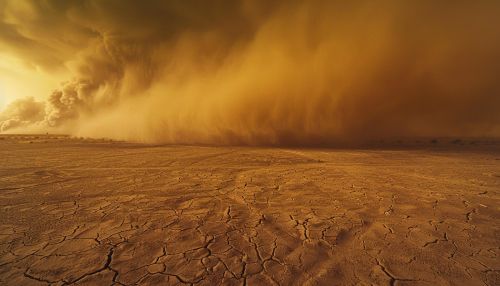Dust Bowl
Introduction
The Dust Bowl was a severe period of environmental degradation and economic hardship that affected the American and Canadian prairies during the 1930s. The event was characterized by severe dust storms that caused major ecological and agricultural damage to the region. This period is associated with severe drought and poor farming practices, resulting in soil erosion and dust storms.
Causes
The Dust Bowl was primarily caused by a combination of severe drought and poor land management practices. In the decades leading up to the 1930s, farmers in the Great Plains had adopted new agricultural technologies that allowed them to rapidly increase the amount of land under cultivation. However, these practices, including the widespread use of the plow, left the topsoil exposed and vulnerable to erosion.
The drought conditions that began in the early 1930s further exacerbated the situation. Without sufficient rainfall to support plant growth, the exposed topsoil quickly dried out. High winds then picked up the loose soil, creating massive dust storms that swept across the region.
Impact
The Dust Bowl had a profound impact on both the environment and the people living in the affected areas. The dust storms caused extensive damage to crops and pastureland, leading to widespread crop failure and the loss of livestock. This in turn led to severe economic hardship for farmers and rural communities.
The dust storms also had serious health impacts. Many people suffered from dust pneumonia, a condition caused by inhaling large amounts of dust. Others experienced malnutrition due to the lack of food.
The Dust Bowl also triggered one of the largest internal migrations in U.S. history. Faced with the loss of their livelihoods, many farmers and their families were forced to leave their homes in search of work elsewhere. This mass exodus was immortalized in John Steinbeck's novel, The Grapes of Wrath.
Aftermath and Lessons Learned
The Dust Bowl had lasting effects on both the environment and the economy of the affected regions. In response to the crisis, the U.S. government implemented a series of measures aimed at preventing a similar disaster in the future. These included the establishment of the Soil Conservation Service and the introduction of new farming practices designed to prevent soil erosion.
The Dust Bowl also led to significant changes in agricultural policy and practice. Farmers were encouraged to adopt more sustainable farming practices, such as crop rotation and contour plowing. These practices not only helped to restore the damaged land, but also made agriculture more resilient to future droughts.
See Also


